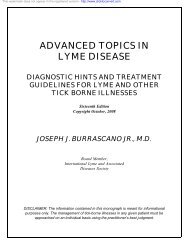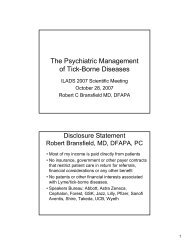Primary care brochure 8 21 08 v2.pub
Primary care brochure 8 21 08 v2.pub
Primary care brochure 8 21 08 v2.pub
You also want an ePaper? Increase the reach of your titles
YUMPU automatically turns print PDFs into web optimized ePapers that Google loves.
Lyme Disease Basics<br />
Lyme disease, a multisystemic illness caused by<br />
the spirochete Borrelia burgdorferi (Bb), is the<br />
most common vector-borne illness in the US.<br />
Approximately 20,000 new cases are reported to<br />
the CDC each year and the CDC acknowledges<br />
that 90% of cases go unreported.[Adler, J. (2004).<br />
Lyme: battles with illness, emotions, insurance.<br />
(NJ) Herald News.] Infected black-legged ticks<br />
transmit Bb to humans via a bite. These ticks are<br />
quite small and easily overlooked; most patients<br />
do not recall being bitten prior to becoming ill.<br />
Lyme disease has both early and late disease<br />
manifestations. Patients may exhibit one or both<br />
of these stages; many patients initially present<br />
with late Lyme disease. Any organ system can be<br />
involved, but Bb commonly strikes skin, joint,<br />
heart and nervous tissue, including the brain.<br />
Early Lyme disease begins 3-30 days after a tick<br />
bite and is readily identified by an erythema migrans<br />
(EM) rash. EMs vary in appearance. The<br />
most common rash is a homogeneously colored<br />
oval lesion. The classic “bull’s eye” accounts for<br />
less than 20% of all EM cases; [Smith R et al,<br />
Ann Intern Med. 2002;136:4<strong>21</strong>-428, Tibbles C,<br />
JAMA 2007; 297:2617-27.] 30% of patients<br />
never have a rash.[MMWR 56(23); 573-576]<br />
Flu-like symptoms such as fever, fatigue,<br />
headache, myalgias, arthralgias and neck stiffness<br />
may accompany an EM or be the only evidence<br />
of early Lyme disease.[Steere A et al, Am J Med.<br />
2003; 114(1):58-62]<br />
Late Lyme disease develops weeks - years later<br />
and is the result of disseminated infection. Early<br />
disseminated Lyme disease may cause multiple<br />
EM rashes, Bell’s palsy or other cranial neuropathies,<br />
meningitis, meningoradiculitis, carditis,<br />
lymphadenopathy and arthralgia; constitutional<br />
symptoms may be present. In endemic areas,<br />
Lyme disease is implicated in 50% of all cases of<br />
Bell’s palsy in children.[Cook SP et al, Am J Otolaryngol<br />
1997; 18(5):320-3]<br />
In the US, arthritis and disorders of the nervous system<br />
are seen in late disseminated Lyme disease. Arthritis<br />
can affect any joint; knees are the most common<br />
site. Up to 60% of untreated patients will experience<br />
arthritis.<br />
Neurologic conditions include peripheral sensory neuropathies,<br />
motor neuropathies, cranial neuropathies,<br />
autonomic dysfunction, movement disorders, neuropsychiatric<br />
illnesses and encephalopathy. Neuroborreliosis<br />
is the term used when Lyme infects the brain.<br />
15 – 40% of Lyme disease patients have neurologic<br />
disorders due to the infection. [Caliendo et al, Psychosomatics<br />
1995; 36:69-74] Late disease can be severe<br />
with marked morbidity and poor treatment outcomes.<br />
Symptoms<br />
The symptoms of Lyme disease are widespread and<br />
variable; relapsing/remitting patterns are common.<br />
The validity of individual symptoms has been documented<br />
in numerous reports and studies on Lyme disease.<br />
Frequently reported symptoms include:<br />
* Extreme fatigue, often interfering with activities<br />
* Headaches of all types<br />
* Recurrent fevers, chills, night sweats<br />
* Myalgias and arthralgias; either may be migratory<br />
* Muscle fasciculations and weakness<br />
* Paresthesias and neuropathic pain syndromes<br />
* Sleep disturbances<br />
* Cranial nerve dysfunction<br />
* Neuropsychiatric problems – irritability, depression,<br />
anxiety, panic attacks, new onset ADHD, mood<br />
swings similar to bipolar disease, rage attacks, OCD<br />
* Cognitive losses: memory impairment, difficulty<br />
multi-tasking, slowed mental processing, speech and<br />
language problems, poor concentration, loss of math<br />
skills, impaired visual/spatial processing<br />
* Children may have behavioral changes, declining<br />
school performance, headache, fatigue, forgetfulness,<br />
complex partial seizures, depression and be misdiagnosed<br />
with primary ADHD.<br />
Although Lyme disease symptoms overlap with symptoms<br />
of other conditions such as fibromyalgia, chronic<br />
fatigue syndrome, MS, early ALS, RA, lupus and psychiatric<br />
disorders, patients with Lyme disease often<br />
have symptom patterns which are atypical for these<br />
other illnesses. Making sense of the multitude of<br />
reported symptoms can be challenging; but bear in<br />
mind that symptoms which appear unrelated may be<br />
linked via an underlying autonomic neuropathy or<br />
encephalopathy.<br />
Physical Exam in Lyme Disease<br />
Lyme disease patients may have exam findings<br />
when <strong>care</strong>fully assessed but findings may be few or<br />
absent in some cases. In addition to a general exam,<br />
detailed neurologic, dermatologic and rheumatologic<br />
exams should be performed.<br />
Serologic Testing in Lyme Disease<br />
Borrelia burgdorferi is very difficult to culture, thus<br />
serologic tests are used to detect the presence of<br />
antibodies to Bb. In 1995 the CDC, in an move to<br />
standardize testing procedures and Western blot<br />
interpretations, published guidelines for laboratory<br />
testing in Lyme disease.[MMWR 1995; 44:590-1]<br />
The CDC recommended a two-tier testing algorithm.<br />
Step 1 is an ELISA or IFA; positive or<br />
equivocal results advance to step 2, IgM and IgG<br />
Western blotting. Samples negative in step 1 are not<br />
tested further. The purpose of standardization<br />
was to establish parameters for laboratory confirmation<br />
of Lyme disease surveillance cases, not<br />
clinical diagnosis.[Mead P. CT Dept of Public<br />
Health Hearing Jan 29, 2004]<br />
Two-tier testing doesn’t work.<br />
The step 1 tests are insufficiently sensitive to be<br />
used as “screening” tests. [Trevejo R, JID 1999;<br />
179:931–8.] Western blots, increase specificity but,<br />
following a step 1 test, further decrease overall sensitivity.<br />
The bands included in the Western blot<br />
interpretation schemes were chosen on a statistical,<br />
rather than a clinical, basis.[Dressler F. JID 1993;<br />
167:392-400.] Recently, the C6 peptide ELISA<br />
alone was proposed as an alternative to the two-tier<br />
approach. Unfortunately, the C6 ELISA also lacks<br />
adequate sensitivity for clinical use.[Bacon R. J<br />
Infect Dis 2003; 187:1187- 99.]<br />
Given the state of the diagnostic testing, Lyme disease,<br />
like many other diseases, is a clinical diagnosis;<br />
with testing playing a supportive role.






